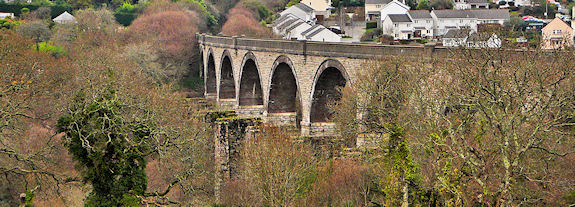
The Cornwall Railway, built to the 2.14m (7 ft 0¼ in) broad gauge, ran from Plymouth to Falmouth. The section from Plymouth to Truro opened in 1859 when the Saltash Bridge was opened. The extension to Falmouth was completed in 1863. The original section remains open as part of the London to Penzance main line, the Truro to Falmouth line being operated as a branch. It was leased by the South Devon, Bristol & Exeter and Great Western Railways, then in 1889 the Cornwall amalgamated with its three associate companies.
The Cornwall Railway viaducts were mostly built on stone piers but with spans of timber fans. This design was chosen by Isambard Kingdom Brunel in order to reduce the cost of their construction, but at the expense of high maintenance costs. The route crossed forty five rivers and deep valleys. Of these, forty two were crossed by timber viaducts of various types. The remainder were the River Tamar at Saltash crossed on the Royal Albert Bridge, the River Fowey at Lostwithiel crossed by a low three-span viaduct (two spans being timber, the central one iron), and the river and canal at Par crossed on a five-arch low stone viaduct.
Replacement of the viaducts started in 1875 but led to a dispute between the Cornwall Railway and the Great Western Railway which leased the line. The lease precluded the conversion of the broad gauge line to standard gauge, and the Cornwall Railway refused to pay for the widening of the viaducts during rebuilding to accommodate a double line of standard gauge tracks (it had been built as a single-track line). Following the amalgamation of the two companies on 1 July 1889, all the remaining viaducts were replaced, those between Saltash and St Germans being replaced by a deviation line, the remainder being either rebuilt in situ or having a replacement viaduct built immediately alongside. Because of this, many of Brunel's original piers still remain today.
The longest viaduct on the Falmouth branch is College Wood, on the southern edge of Penryn. It is 291 m (995 ft) long and has eleven arches with a maximum height of 30 m (100 ft). Being on a curve and only single track it is impressive. Some 400 m (0.25 miles) north there is another viaduct known as Penryn Viaduct. It is smaller having only six arches.
By road: Off A39, via College Hill. Best seen on foot in College Wood though there may be some marvellous views from upstairs bedrooms in Glasney Place, Saracen Way and Poisethow.

Bennett, Alan, The Great Western Railway in Mid Cornwall, Kingfisher Railway Publications, ISBN 0-946184-53-4 (1988)
Biddle, Gordon, Britain's Historic Railway Buildings, Oxford University Press, ISBN-10: 0198662475 (2003)
Biddle, Gordon & Nock, O.S., The Railway Heritage of Britain : 150 years of railway architecture and engineering, Studio Editions, ISBN-10: 1851705953 (1990)
Biddle, Gordon and Simmons, J., The Oxford Companion to British Railway History, OUP, ISBN 0 19 211697 5 (1997)
Binding, John, Brunel's Cornish Viaducts, Atlantic Transport Publishers, ISBN 0-906899-56-7 (1993).
Clinker, C.R., The Railways of Cornwall 1809 - 1963, David and Charles, ASIN: B0006EWOPE (1963)
Conolly, W. Philip., British Railways Pre-Grouping Atlas & Gazetteer, Ian Allan Publishing, ISBN 0-7110-0320-3 (1958/97)
MacDermot, E. T., History of the Great Western Railway, volume II 1863-1921, Great Western Railway (1931).
Osler, Edward. History of the Cornwall Railway 1835-1846, Avon-Anglia Publications, ISBN 0-905466-48-9 (1982
Smith, Martin. British Railway Bridges and Viaducts. ISBN 0 7110 2273 9 (1994)
Woodfin, R. J. The Cornwall Railway to its Centenary in 1959, Bradford Barton, ASIN: B0019AOVAU (1972)
Forgotten Relics - Listed Bridges and Viaducts